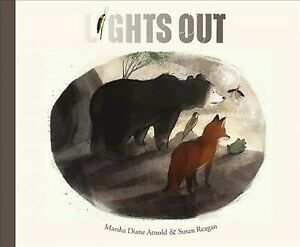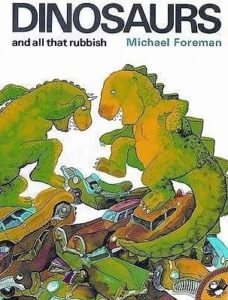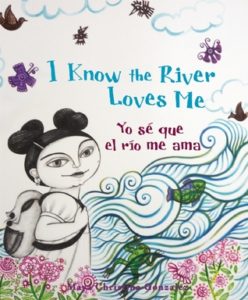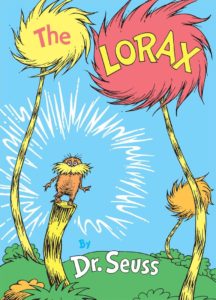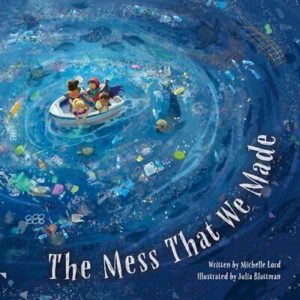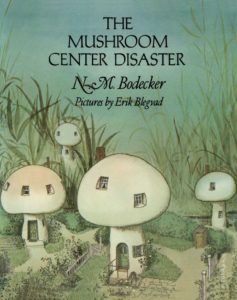 This month’s Author Interview is with Marsha Diane Arnold. Her books have sold over one million copies, so what more do you need to know? 🙂
This month’s Author Interview is with Marsha Diane Arnold. Her books have sold over one million copies, so what more do you need to know? 🙂
Alright, I’ll share a bit more.
Marsha’s lived on the West Coast, the Middle, and now, The East Coast (Florida), and she claims to love them all, but I think it’s clear which her favorite is. In addition to loving reading and writing, she’s a fan of bicycling, swimming, gardening, and scuba diving.
Her 23rd picture book, One Small Thing, just came out in May. Don’t worry, we’ll talk about it, along with a lot of other things.
Here are her social URLs.
And let’s end this introduction with a poem she wrote. Enjoy!
THE STORYMAGICIAN’S CHANT
I’m a StoryMagician.
I play with words.
I arrange them in stories
So they can be heard.
I’m a StoryMagician.
I imagine new worlds.
I bring them to life
Like a shiny new pearl.
I’m a StoryMagician.
I’m awake! I’m aware!
I sit with my notebook
Writing stories to share.
MDA: “The Storymagician’s Chant” is one I used as a call and response with students, during school visits. We had a lot of fun. I can already tell this interview is going to be a lot of fun, too. Thank you for inviting me, Ryan!
RVC: You bet! Now, please share three words that describe your childhood.
MDA: Farmgirl, family-oriented, barefoot.
RVC: When did you realize you were going to be a writer?
MDA: I always loved reading and books. I majored in English literature in college, but I never thought about being a writer myself. That is, not until my children were born and I started writing a weekly newspaper column entitled homegrown treasures. It was about children, family, and life, usually from a humorous, yet heartfelt, perspective. One reviewer said of it: “She finds a universe in her backyard!” I was a writer!
RVC: How did that weekly column help prepare you for your work as a kidlit author?
MDA: I asked the editor of the newspaper if I could use a pseudonym for my homegrown treasures column; I was so nervous about people judging me. He advised that wasn’t a good idea for a local newspaper columnist. Ha. I was finally persuaded; my first column was published under Marsha Arnold.
During those ten years of writing a weekly column, I learned about discipline, structure, word limit, and how to write subtle humor. My true love was picture books, so during those ten years I also started a writer’s group for picture book authors. My first picture book was published ten years after I began writing homegrown treasures. By then, I wasn’t quite as nervous about people judging me. My first picture book was published under Marsha Diane Arnold.
RVC: What’s the story behind your first published book?
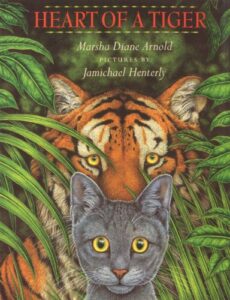 MDA: My first book, Heart of a Tiger, was published in 1995. That was a long time ago and my memory is fading.
MDA: My first book, Heart of a Tiger, was published in 1995. That was a long time ago and my memory is fading.
RVC: I’ll take whatever you recall or whatever you want to make up! 🙂
MDA: I think I was writing the story about myself, for myself. I only realized this long after it was published. Like the small kitten, Number Four, I wanted to give myself a name like Beautiful Bengal on Naming Day, but, like Four, I wasn’t worthy of that name and had no idea how to become worthy.
In a way, I wrote the story to show how each of us can find the courage to follow a “Magnificent One” and learn to become worthy. Even if what you aspire to is not possible, as it was not possible for Four to become a Bengal Tiger, what you hold in your heart can “grow in wisdom and power as you grow.”
RVC: What was the most important lesson you learned with that book?
MDA: Perhaps the most important lesson I learned from Heart of a Tiger was that I could do it. I could write a story that touched readers. Heart of a Tiger received some nice accolades – Best First Book by A New Author, three Children’s Choice Awards, Junior Library Guild Selection, and more. I could do it! I could “grow in wisdom.”
RVC: What a nice thing to happen with a first book!
MDA: More heartwarming than the awards was the personal reactions of readers. I autographed a book for one young reader when he was eight. Years later, after graduating from high school, he wrote to tell me that he still had the book and that whenever he had to make a difficult decision, he would reread it, using it as a guide.
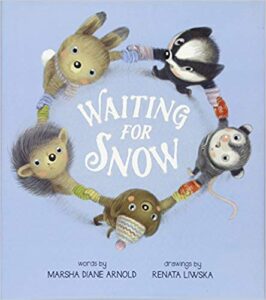 RVC: Speaking of cool lessons, Waiting for Snow has a wonderful lesson about patience. How did you craft the narrative to deliver this message effectively for young readers?
RVC: Speaking of cool lessons, Waiting for Snow has a wonderful lesson about patience. How did you craft the narrative to deliver this message effectively for young readers?
MDA: I do love those patience lessons. Waiting is hard for everyone, especially for little ones. My book Badger’s Perfect Garden has a secondary theme of patience too. I believe my guiding light for Waiting for Snow was from Ecclesiastes: “For everything there is a season, and a time for every matter under heaven.” I do trust my guiding lights.
Messages are much more likely to be heard if humor is involved and if the story doesn’t go on too long. I recall working on that subtle humor for Waiting for Snow. I also cut my story over and over; I cut a character or two as well.
RVC: What was the biggest challenge with that book?
MDA: The biggest challenge may have been using quiet humor to show the friendship and support of Badger’s friends, even when they had different opinions.
My brilliant editor, Kate O’Sullivan, helped me “kill some of my darlings,” to create space so Renata Liwska’s always amazing illustrations could tell part of the story. I was happy to do so. Renata brought forth just what I wanted to show: Badger’s impatience and ingenuity. Waiting for Snow is actually dedicated to Kate and Renata, a dream editor and illustrator worth waiting for.
RVC: Let’s talk art notes. Where do you stand with these?
MDA: I like art notes, but they must be efficient. They must be succinct. And they must not intrude on the illustrator’s creative vision.
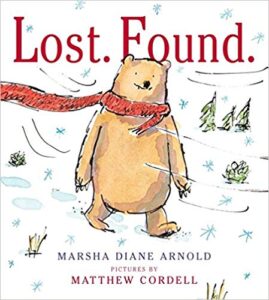 In my nearly wordless book Lost. Found., illustrated by Matthew Cordell, I used lots of art notes. After all, there were only 18 words in the book. It needed some art notes!
In my nearly wordless book Lost. Found., illustrated by Matthew Cordell, I used lots of art notes. After all, there were only 18 words in the book. It needed some art notes!
RVC: What about rhyme?
MDA: I like rhyme, too! But it certainly can be challenging. For me, one of the challenges with a rhyming story, besides finding all those perfect rhyming words, is to give it that second layer of meaning, that depth, along with the lighthearted rhyme.
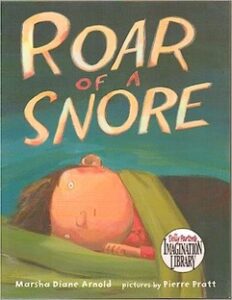 Roar of a Snore, my 2006 book from Dial, was an accumulated rhyming story. Children loved it, even memorizing it. It was a Dolly Parton Imagination Library selection three years in a row.
Roar of a Snore, my 2006 book from Dial, was an accumulated rhyming story. Children loved it, even memorizing it. It was a Dolly Parton Imagination Library selection three years in a row.
RVC: Nice!
MDA: My agent is currently submitting a rhyming manuscript for me. It’s humorous like Roar of a Snore. I’d really like to have another funny book published, but that kind of success is hard to replicate.
RVC: Please share one of your favorite moments (or a breakthrough) in your writing career.
MDA: I have experienced so many wonderful moments at the schools I’ve visited during my writing career. There was the school that had all the classes come into the auditorium in a conga line, drumming, in honor of Prancing Dancing Lily. There was the time the principal drove me to the school and I saw a huge constructed tornado on their roof! It was in honor of my book, The Bravest of Us All. What a grand time I had on school visits.
RVC: School visits can be awesome! Now, let’s talk about your most recent book, One Small Thing. What’s the logline?
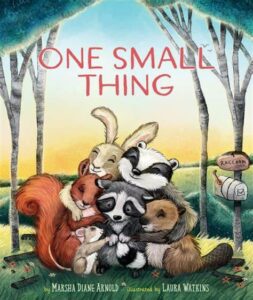 MDA: When Raccoon’s home is destroyed by a lightning strike, the creatures of Brightly Wood think they’re too small to be of any help. But after returning to their homes and their individual lives, they pause and reflect, finally realizing they can each do one small thing.
MDA: When Raccoon’s home is destroyed by a lightning strike, the creatures of Brightly Wood think they’re too small to be of any help. But after returning to their homes and their individual lives, they pause and reflect, finally realizing they can each do one small thing.
RVC: This book and others you’ve written have a strong connection to nature. What inspired this in your writing?
MDA: I grew up on a farm in Kansas, near a lake. I spent summers with my grandparents, who lived in a small Colorado town, near streams and mountains. I’ve always loved nature and wildlife. I feel most at home in nature, surrounded by wildlife. So, it’s natural, I think, that nature inspires my writing.
RVC: In this book, how did you decide on the range of animal characters and their unique personalities?
MDA: I am definitely a pantser writer. I usually come up with a title and that title acts as a beacon, leading me through the story. My characters usually come to me rather easily, as if they’ve walked up and knocked on my door. I invite them in and we become friends quite quickly. I love that my character friends are so different, with different personalities and different ways of viewing the world.
RVC: That’s a lovely way to explain how a story comes together. What happens next?
MDA: I weave in little things as the story moves along, little things that help the reader know the characters. We know Raccoon loved his home by the river and that he had a pet cricket. That tells us a lot. We know Beaver, busy as she always is, gets to work on a new house for Raccoon right away. We are a bit surprised that grumpy Badger is so worried about Cricket and goes into the darkest part of Brightly Wood searching for “that silly cricket.” Of course, we needed an animal (Mouse) who made herb balms to soothe Raccoon’s burned feet, an animal who brewed calming teas (Squirrel) and an animal (Rabbit) who liked honey and honey bread, to provide nourishment. All together, the animals provide Raccoon’s basic needs and much more.
RVC: Let’s talk about process. How do you handle writer’s block and keep your creativity flowing?
MDA: I’m not a writer who writes daily…or even weekly. So, maybe I have writer’s block and don’t even know it! But when I am working daily on a project and get stuck, I go for a walk in nature or take a swim. Five minutes in the oak tree swing often works, too.
RVC: How has your writing evolved since you first started?
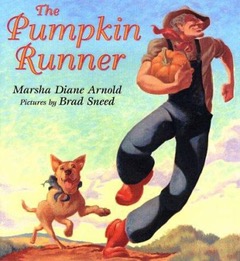 MDA: I used to meander about in my stories more than I do now. One reviewer referred to “Arnold’s meandering style,” even though she gave me an excellent review. That was in reference to The Pumpkin Runner, which was published in 1998. I love storytelling styles that take a journey up the hill or over the river before coming back to the main road, but those stories are harder to sell in today’s market. So, I try to reign my meandering ways in.
MDA: I used to meander about in my stories more than I do now. One reviewer referred to “Arnold’s meandering style,” even though she gave me an excellent review. That was in reference to The Pumpkin Runner, which was published in 1998. I love storytelling styles that take a journey up the hill or over the river before coming back to the main road, but those stories are harder to sell in today’s market. So, I try to reign my meandering ways in.
RVC: Are there any aspects of your writing that have remained consistent?
MDA: One person recently asked me, “How do you create depth and simplicity simultaneously?” That sounded more like a wonderful compliment than a question. Once I stopped blushing, I realized that I’ve likely always done that intuitively. It may be because I respect my audience so much. I know children can understand depth. The simplicity part is perhaps because the truest things are simple, humble, and unassuming.
RVC: Share a bit about how you revise. How do you know when a manuscript is ready to send out?
MDA: I rely a lot on my two writing critique groups. Once I have what I think is a good draft, I share my manuscript with them. After I ponder their feedback, I read my story aloud, over and over again, checking for rhythm, lyricism, wordiness. Is it ever really ready? Probably not, but at some point, we have to let go.
RVC: What’s the most valuable piece of feedback you’ve ever received on your writing?
MDA: For me, the most valuable feedback is encouragement. Fairly early in my career, a librarian said, “Marsha Diane Arnold and her books treat kids as thinkers and speak of good things…kind of like Mr. Rogers.” I couldn’t ask for much more encouragement than that.
RVC: What role did SCBWI play in your writing career?
MDA: One of the first things I did when I decided to write for children was join the Society of Children’s Book Writers and Illustrators. I think anyone serious about writing for children should be a member. They have been there from the beginning of my career, providing information and inspiration. In 2021, my Lights Out was a finalist for the SCBWI Golden Kite Award for picture book text. Thank you, SCBWI!
RVC: One last question for this part of the interview. What’s next for you? What should we be on the lookout for?
MDA: My next book will be out August 8th! Armando’s Island is an ode to the rainforest, its precious creatures, and those who bravely stand against its destruction. My hope is to bring awareness to the beauty and value of the world’s rainforests.
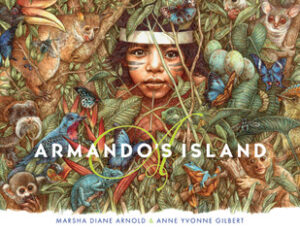 I wanted to bring my readers intimately into Armando’s world, so I used as much sensory detail as I could. The illustrations by Anne Yvonne Gilbert are spectacular. And when, on the opening spread, the child Armando looks directly at the reader, I feel intimacy is achieved.
I wanted to bring my readers intimately into Armando’s world, so I used as much sensory detail as I could. The illustrations by Anne Yvonne Gilbert are spectacular. And when, on the opening spread, the child Armando looks directly at the reader, I feel intimacy is achieved.
I’m also excited about a manuscript I contracted for in January. Any day now I’ll be able to share the current title and who the illustrator will be, but not this day.
RVC: Alright, Marsha. It’s time for the much-ballyhooed, never-equaled SPEED ROUND. Let’s keep the questions fast and the answers even faster. Are you ready?
MDA: Never. But let’s start anyway!
RVC: If you could only have one app on your phone, it’d be…
MDA: I could probably live without them all, but I do use Messages a lot. Is that considered an app. You see how techie I am?
RVC: If they made a movie about your writing career, what would the title be?
MDA: Meandering Marsha Stumbles Along; Serendipity Saves Her.
RVC: What makes your eyes roll every time you hear it?
MDA: The “word” “Anyways.”
RVC: What do you think you’re much better at than you actually are?
MDA: Nothing. I have a rather big inferiority complex.
RVC: Am I missing anything? What’s the question nobody ever asks you, but you wish they would?
MDA: What an intriguing question. Now I not only don’t know the answer to the question, I don’t know the question! Let’s see…
Here’s the question: “Your writing can be on the serious side. Do you ever do silly things?”
RVC: What’s the answer to that?
MDA: Yes, I’m serious-minded, but I love to laugh and I laugh a lot. I can be silly. I see humor all around us. I can dance around the living room with my poodle. I can forgive myself and you too, if we get too serious. If you knew me well, you’d know that Joyful is my middle name, right next to Diane.
RVC: Final question. What’s the best feedback a kid’s given you?
MDA: Well, “I think you are the best writer in the whole galaxy,” was pretty nice. Then again, “You are one of my superheroes. One is my dad, the other is Jesus, and you,” was quite astounding.
RVC: Thanks so much, Marsha!
MDA: Thanks to you, Ryan…I think. This was almost as hard as writing a book! Just kidding. It was so kind of you to invite me to join you on this writerly interview. What fun!



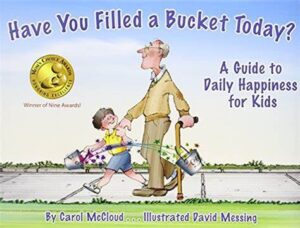
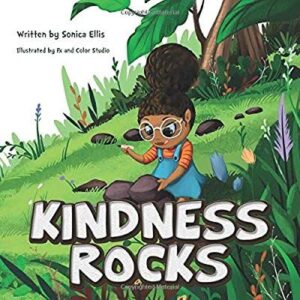
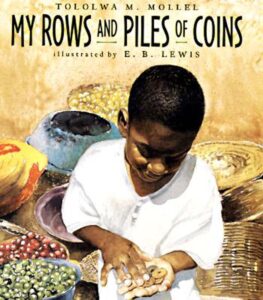
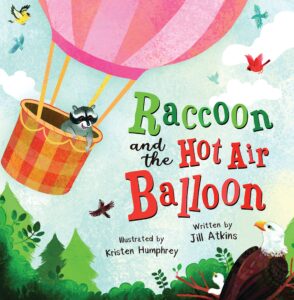
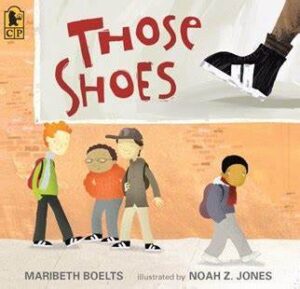
 This month’s Author Interview is with Marsha Diane Arnold. Her books have sold over one million copies, so what more do you need to know? 🙂
This month’s Author Interview is with Marsha Diane Arnold. Her books have sold over one million copies, so what more do you need to know? 🙂


 Roar of a Snore
Roar of a Snore

